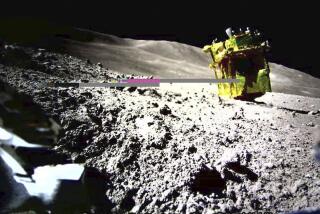Galileo Won’t Need Orbit Adjustment : Science: The spacecraft’s Jupiter mission is going so well, scientists will skip path corrections and await information.
- Share via
So perfectly did the Galileo spacecraft fire its engines and ease into Jupiter’s orbit that path corrections planned for today were canceled, NASA scientists said Friday.
The spacecraft seemed to be in great shape a day after Galileo’s 745-pound probe parachuted into the giant planet’s gaseous layers and the orbiter engine burned for 49 minutes to set the spacecraft on course for a two-year odyssey among the planet’s moons.
The historic mission marks the first time a remote probe has peeked behind the thick cloud curtain of one of the four giant outer planets of this solar system.
A NASA navigation team met Friday morning and determined that “the orbit we are in is so good” they can skip a planned adjustment today, said Matt Landano, deputy Galileo mission director at NASA’s Jet Propulsion Laboratory in Pasadena.
Galileo still can make orbit corrections--if necessary--in March, when the main engine will fire again to set the course for the next Jupiter approach, Landano said.
Although Galileo came within 160,000 miles of the banded planet Thursday, the next approach will come no closer than 420,000 miles, to safeguard against exposure to potentially damaging radiation.
The cone-shaped atmospheric probe is presumed to have been crushed and vaporized in the extreme pressure and high temperature of Jupiter’s unseen inner reaches sometime after the orbiter cut off radio contact 75 minutes into the plunge. But the tiny vehicle’s contribution lives on in instrument readings taken on the parachute ride to oblivion.
Engineers expect by Wednesday to retrieve the first 40 minutes of data collection. A quick analysis of that information will be released Dec. 19 at NASA’s Ames Research Center in Mountain View, which supervised the probe mission. More information will be analyzed later.
Landano said Galileo got closer to Jupiter’s heavy radiation belts than past fly-bys by Pioneer or Voyager. That engineers--on the basis of patchy information from earlier voyages--could protect the craft from conditions only partially understood is miraculous, he said.
“We used the data of those two spacecraft and then had to apply engineering judgment as to what we believe we might be seeing or that we might encounter much closer in. Then we designed all of our shielding to do that--and it worked!” Landano said with a laugh. “Now we know for sure: We did a good job.”
Approved by Congress in 1977 and launched in 1989, Galileo brushed with disaster on several occasions. The failure of its main antenna to open in 1991 drastically reduced the amount of information it could transmit, although scientists ingeniously reprogrammed its computers and turned its low-power antenna into a workhorse.
A malfunctioning tape recorder has been fixed, but to be cautious, engineers saved high-speed recording Thursday for probe activities, thereby sacrificing a chance to record unique images of Jupiter’s moon Io during a close fly-by.
Paul Weissman, a senior research scientist who works with the infrared spectrometer that creates those images, was dejected during Thursday’s general elation.
“We’ve got nothing to show for today,” he said.






